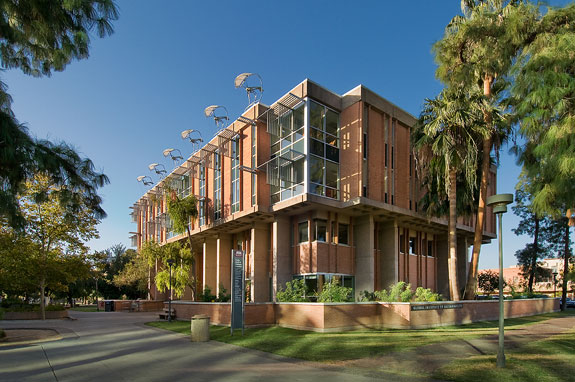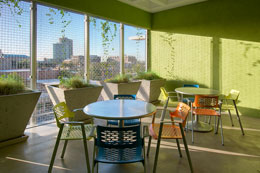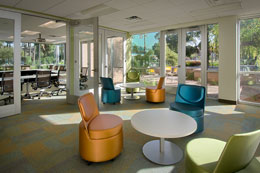
ASU's School of Sustainability - (c) 2008 Mark Boisclair Photography
Think of it as re-modernizing an old out of date building with new eco-friendly modern architecture, efficient green features, and a targeting silver-level LEED certification from the U.S. Green Building Council. The old Arizona State University Nursing Building underwent a $3 million renovation and upgrade primarily for asbestos abatement; fire and life safety, HVAC and lighting system upgrading; and making the elevators, stairways and restrooms ADA compliant. The home of the new School of Sustainability, the Global Institute of Sustainability Building is quite an impressive restoration and renewal and is the hub of Arizona State University’s sustainability initiatives. Its School of Sustainability, the first of its kind in the United States, offers transdisciplinary degree programs that explore and advance practical solutions to environmental, economic and social challenges.
Responsible design was used throughout the redesign to transform the dark 1960s-era structure with cavernous hallways into a bright, open, eco-friendly facility. Improvements will result in an anticipated 18.7 percent on energy use and 50.3 percent on water use. This is achieved through the use of renewable energy from six wind turbines mounted on the roof’s eastern edge and powered by thermal updrafts providing 1,000 watts of power to the Arizona Public Service grid on windy days. The roof will house a 24-kilowatt photovoltaic solar array eventually collectively providing 7.4 megawatts of power to the University’s Tempe campus (when grouped with other campus buildings), and will soon to be the largest such array in the United States. Low-flow toilets, waterless urinals, timer-based faucets and automatically monitored landscaping irrigation save water and pervious paving surrounding the site controls storm water runoff.
The interior of the building also makes use of a wide variety of high recycled content products such as countertops made from recycled milk jugs inlaid with shavings from recycled cans and GreenGuard® Indoor Air Quality Certified furniture; as well as low VOC-emitting paints, carpet, flooring, gypsum sheathing and interior signage. Overall ambient light is increased through the control of natural light by interior layout and strategic placement of windows and shading. The renovations provided for a much more airy and open feel, while still maintaining some of the design elements of the 60’s vintage building.
It is encouraging to see sustainable design and renewable energy being used on college campuses used in tandem with education. Green and Efficient building practices are the future of development, and this provides new standards for students to achieve and exceed.
[via Jetson Green]
